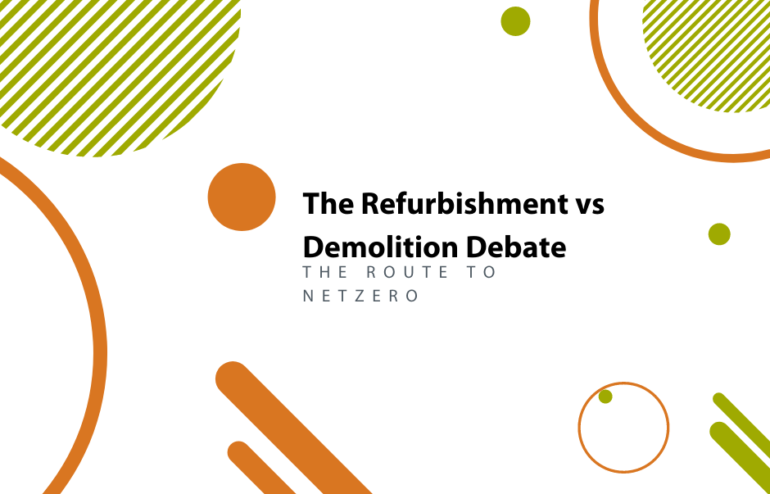The Refurbishment vs Demolition Debate

Balancing the desire to demolish over refurbishment
by Patrick Watson
Demolition vs refurbishment has been a long-standing debate in the construction industry, particularly with the increasing focus on sustainability and achieving a low carbon economy. Responses to the World Green Building Council (GBC) 2050 targets are stimulating the need for change. #COP26 did a lot to raise the low carbon profile but has not yet achieved the change that is necessary. The call for specific deliverables and targets to be established at #COP27 only heightens this drive. Whist the increasing commitment of organisations to Scienced Based Targets can only be applauded, is it time for specific targets favouring refurbishment over demolition to be established?
Ultimately, for this to be effective we need to change established mindsets. Capital projects in the Built Environment (BE) are generally seen as a catalyst to change and with the established practice of sweeping out the old for the new, an increased level of carbon expenditure becomes mandated. However, the rising concern over the impact of the BE on global emissions is going to further stimulate a cultural shift. Carbon must become a recognisable resource to be measured monitored & used effectively. In our ever material world, balancing carbon with the project fundamentals of cost & time must be achieved, priorities set, and goals established.

Increasingly efforts are focused on reduction in the Embodied carbon impact of BE schemes for example, via campaigns by RIBA and other key industry bodies. Whilst the “new shiny thing” may well be vastly more efficient in use, the additional carbon penalty generated by the industry’s inability to reuse buildings is a far greater penalty – taking decades to achieve payback.
Planning policy is now also seeking to focus on the carbon footprint of the building. Marks & Spencer recently made the headlines by being challenged over its climate impact. The planned demolition of its 90-year-old flagship store on Oxford Street and replacement with a new structure would have generated so much CO2e that 2.4m trees would need to be planted to offset it!
Numerous high-profile schemes are currently being marketed as #NetZero when this has only been achieved by the green washed technique of “off-setting”. In an ever-conscious carbon budgeting world the business case for retention is increasingly viable and off-setting will be seen for what it truly is – obfuscation.
Sadly, some buildings are just not suitable for conversion or renovation due to a variety of functional factors; from foundation strength or plot size to internal layout which cannot be altered for technical reasons. However, briefs can and should be challenged. For example, if the desire for one element requires a significant increase in the carbon expenditure, should this really be part of a project’s brief?
Fundamentally, if the structure of the building involved is sound and renovation is mostly internal (i.e. based on altering room layouts), then renovation can be the cheaper option. Add in the environmental benefits and the case for re-use becomes established.
3PM’s experience of deep low energy refurbishment has recognised some significant challenges, where cementing a cultural shift and retention mindset becomes key. Creating the drive for the professional teams to actively think about using and doing less is fundamental. This coupled with all new material being selected based on its contribution to the wider goal of carbon reduction. The adoption of the circular economy principles; Re-use, reduce, recycle have been key to achieving shifts in the psychologies of project teams and as an added bonus have developed some increasingly recognisable architectural styles.
For effective change, values & vision must be clear, and this then needs to be translated into SMART objectives. Deep energy retrofits are complex, project risks can be heightened, and solutions require greater effort and transparency in the development of the right solutions. The project team needs to buy into the vision from the outset and the Project Manager must refer back to the SMART objectives to ensure they are being met at each project stage.
In our ongoing global design competition for London School of Economics the primary aim is for the creation of a low carbon facility to contain the Firoz Lalji Global Hub. The proposition has been established for design entries to propose either retaining part of the core structure to save embodied carbon – although this could require careful balancing to achieve desired efficiency and floor areas – or demolition to street level while preserving most basement areas.

The refurbishment vs demolition cause is increasingly challenging but whilst harder it should not prevent us all from doing the right thing. 3PM as independent creative Project Managers are well placed to solve these increasingly complex problems with our central mission being to provide solutions that make life better for everyone. To achieve this, the sustainability and low carbon agenda is fundamental.

